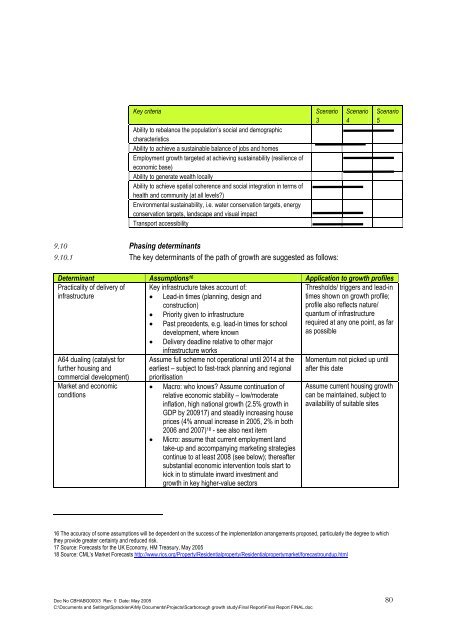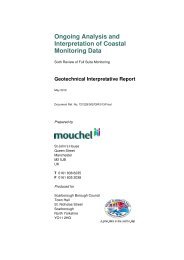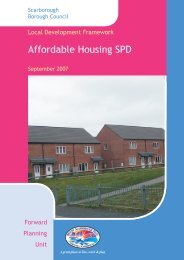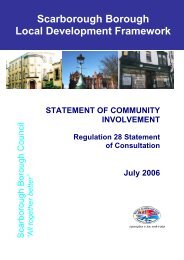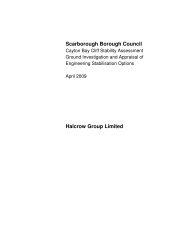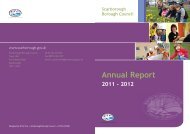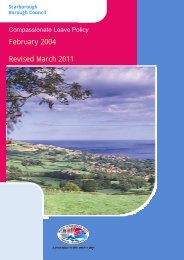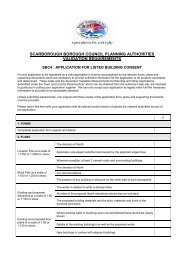Growth of Scarborough Study - Scarborough Borough Council
Growth of Scarborough Study - Scarborough Borough Council
Growth of Scarborough Study - Scarborough Borough Council
You also want an ePaper? Increase the reach of your titles
YUMPU automatically turns print PDFs into web optimized ePapers that Google loves.
Key criteria<br />
Ability to rebalance the population’s social and demographic<br />
characteristics<br />
Ability to achieve a sustainable balance <strong>of</strong> jobs and homes<br />
Employment growth targeted at achieving sustainability (resilience <strong>of</strong><br />
economic base)<br />
Ability to generate wealth locally<br />
Ability to achieve spatial coherence and social integration in terms <strong>of</strong><br />
health and community (at all levels?)<br />
Environmental sustainability, i.e. water conservation targets, energy<br />
conservation targets, landscape and visual impact<br />
Transport accessibility<br />
Scenario<br />
3<br />
Scenario<br />
4<br />
Scenario<br />
5<br />
9.10 Phasing determinants<br />
9.10.1 The key determinants <strong>of</strong> the path <strong>of</strong> growth are suggested as follows:<br />
Determinant Assumptions 16 Application to growth pr<strong>of</strong>iles<br />
Practicality <strong>of</strong> delivery <strong>of</strong><br />
infrastructure<br />
A64 dualing (catalyst for<br />
further housing and<br />
commercial development)<br />
Market and economic<br />
conditions<br />
Key infrastructure takes account <strong>of</strong>:<br />
• Lead-in times (planning, design and<br />
construction)<br />
• Priority given to infrastructure<br />
• Past precedents, e.g. lead-in times for school<br />
development, where known<br />
• Delivery deadline relative to other major<br />
infrastructure works<br />
Assume full scheme not operational until 2014 at the<br />
earliest – subject to fast-track planning and regional<br />
prioritisation<br />
• Macro: who knows? Assume continuation <strong>of</strong><br />
relative economic stability – low/moderate<br />
inflation, high national growth (2.5% growth in<br />
GDP by 200917) and steadily increasing house<br />
prices (4% annual increase in 2005, 2% in both<br />
2006 and 2007) 18 - see also next item<br />
• Micro: assume that current employment land<br />
take-up and accompanying marketing strategies<br />
continue to at least 2008 (see below); thereafter<br />
substantial economic intervention tools start to<br />
kick in to stimulate inward investment and<br />
growth in key higher-value sectors<br />
Thresholds/ triggers and lead-in<br />
times shown on growth pr<strong>of</strong>ile;<br />
pr<strong>of</strong>ile also reflects nature/<br />
quantum <strong>of</strong> infrastructure<br />
required at any one point, as far<br />
as possible<br />
Momentum not picked up until<br />
after this date<br />
Assume current housing growth<br />
can be maintained, subject to<br />
availability <strong>of</strong> suitable sites<br />
16 The accuracy <strong>of</strong> some assumptions will be dependent on the success <strong>of</strong> the implementation arrangements proposed, particularly the degree to which<br />
they provide greater certainty and reduced risk.<br />
17 Source: Forecasts for the UK Economy, HM Treasury, May 2005<br />
18 Source: CML’s Market Forecasts http://www.rics.org/Property/Residentialproperty/Residentialpropertymarket/forecastroundup.html<br />
Doc No CBHABG000/3 Rev: 0 Date: May 2005 80<br />
C:\Documents and Settings\SpracklenA\My Documents\Projects\<strong>Scarborough</strong> growth study\Final Report\Final Report FINAL.doc


